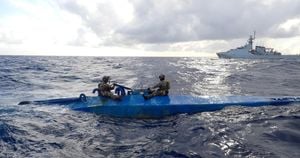Authorities from multiple countries recently made headlines by seizing over 225 metric tons of cocaine during a six-week operation targeting drug trafficking routes operating from South America to Australia. This major bust, part of the global naval operation known as 'Orion,' saw authorities disrupt what they described as increasingly sophisticated trafficking networks using advanced methods to transport drugs across vast distances.
Among the highlights of the operation was the discovery of cutting-edge vessels known as the "narco subs"—semisubmersibles crafted to avoid detection. These vessels are capable of traveling around 10,000 miles without needing to refuel, making them ideal for transporting illegal cargo across oceans. Colombian officials reported finding one such vessel carrying five tons of cocaine headed for Australia, underscoring the growing sophistication of drug traffickers.
The Colombian Navy, which led many of the investigative efforts, described the operation's success as potentially the largest seizure of cocaine made by Colombia to date. Colombian President Gustavo Petro shared via social media the significance of these efforts, noting the crippling impact on drug cartels, which lost over $8.4 billion due to these operations.
This unprecedented crackdown, which resulted in the arrests of more than 400 people involved, was executed with the collaboration of security agencies from the United States, Brazil, Spain, and the Netherlands, showing the global nature of the fight against drug trafficking.
Vice-Admiral Orlando Enrique Grisales of the Colombian Navy explained the reasoning behind the operation's creation. Cartels were adapting to law enforcement efforts and establishing complex networks to increase profitability. He pointed out, "It is not just a pyramid structure as the cartels once were. Today they are organized crime networks joined together, operating with alliances across multiple continents."
Major drug operations like this one are part of Colombia's broader fight against the illegal drug trade. The country, recognized as the largest cocaine producer globally, had already set new records last year for coca leaf cultivation, the raw material for cocaine. These recent drug busts indicate not just the persistence of drug trafficking but also its evolution, as cartels seek new and lucrative markets.
Grisales highlighted Australia as a particularly profitable destination. A kilogram of cocaine can fetch prices as high as $240,000 there, which is approximately six times more than its value in the United States. These financial incentives make for enticing targets for traffickers, driving them to develop more sophisticated routes and methods of transport.
The operation revealed previously unreported alliances between drug cartels not only from Colombia but also from Mexico, Brazil, Ecuador, and Peru, linking them to organized crime groups across Europe and Oceania. This collaboration has made tracing and cutting off drug supply chains increasingly complex.
One key aspect of the operation was the interception of semi-submersible vessels. These ships, often skimming just beneath the water's surface, are difficult to detect with conventional surveillance. The sinister charm of such craft lies in their ability to slip past varying levels of maritime detection and are routinely found loaded with drugs, en route to destinations across multiple continents.
The effectiveness of the operation, with its strategic targeting of coastlines, rivers, and ports, demonstrated international cooperation's role in combatting organized crime. Across the globe, law enforcement agencies are increasingly recognizing the necessity of working together to disrupt these networks effectively.
Although the Colombian government has been facing challenges in curbing coca cultivation and cocaine production, it remains steadfast. The sheer scale of drug interdiction efforts such as Operation Orion signals to authorities and citizens alike the dedication to reclaiming coastal waters from drug activity and ensuring greater safety for communities impacted by drug violence.
Vice-Admiral Grisales emphasized, "It has been found these semi-submersibles, sometimes submersibles, are now increasingly sophisticated with fine engineering," referring to the technological advancements made by drug traffickers adapting to evade detection.
Colombian authorities continue to refine their strategies against drug trafficking. Task forces are now utilizing intelligence-sharing initiatives to not only apprehend suspects but to dismantle entire networks operating at high levels across the globe.
The impact of the seizure is particularly noteworthy not just for its immediate disruption of trafficking but also for its broader message: drug cartels will face consistent and coordinated resistance from law enforcement across nations, sending out the signal of vigilance and cooperation.
Despite these gains, the fight against drug trafficking remains fraught and complex. With drug production at record levels, tactics employed by traffickers grow more sophisticated. The seizing of vast quantities of illegal substances such as those recovered during Operation Orion serves to both highlight these challenges and the response required from international authorities.
The Australian Federal Police and the Australian Border Force acknowledged the operations but chose not to comment on the specifics, cognizant of the sensitive nature surrounding drug interdiction efforts. Authorities continue to monitor for updates on the trafficking routes as collaborative vigilance remains imperative.
Overall, Operation Orion stands as both a landmark achievement and a reminder of the perpetual challenge posed by global drug trafficking networks. Despite significant victories, the emergence of new routes and methods reminds authorities and the public alike of the volatile nature of this issue. Efforts continue as officials assert their commitment to tackling one of the greatest threats facing communities, both local and global.
Looking forward, the Colombian Navy is preparing to bolster defenses against these trafficking routes, aware of the continuous battle raging under the waves. Vice-Admiral Rozo affirmed the necessity of increased international collaboration undisputedly, stating, "We have discovered innovative trafficking routes such as Australia and Guyana to open up through the Atlantic to Africa and connect to Europe."
These developments will likely shape the conversation around drug trafficking for years to come. With the drug trade adapting and shifting, authorities require persistent vigilance and clarity as they confront the ever-evolving tactics employed by those aiming to exploit new markets.



